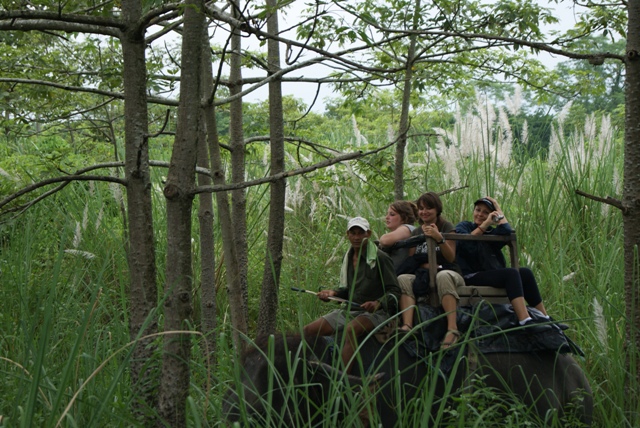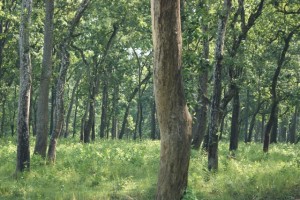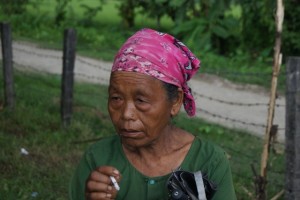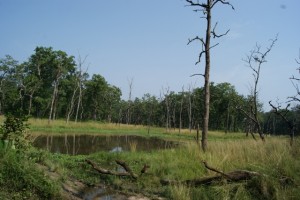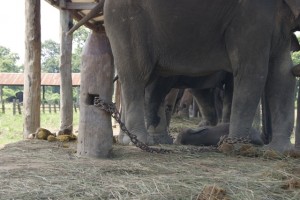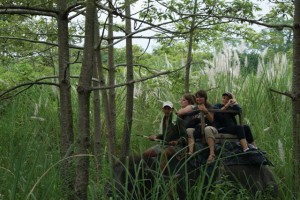One sinewy heave-ho from our boatman and we were off. The ride gave us lovely views of the forest. Mahendra kept pointing out the blink-and-you-miss birds to the carefully camouflaged gharials and marsh muggers – quite hard to miss once you spot them, on the other hand. There they were sunning themselves, lessons in languid repose. Sure enough, I began to view the gently flowing river with a newfound respect. Okay, fear. I kept peering over the edges of the dugout more often now. Lake Placid.
Save for the powerful ‘plok’ of the oar as it cut into the water, we didn’t make much sound and wove our way through the buffer zone. Trekking and canoe rides are allowed till the buffer zone only – beyond which passage is denied for both natives and tourists. Real jungle lies beyond the buffer zone – but it is a protected area and the locals do not hesitate to share chilling accounts of trespassers either killed or brutally mangled. Almost a reminiscent of the boat ride in Pokhara, but this one was, well, more real. Here I was floating right next door to a real forest, giving me occasional glimpses of its inner sanctum. There was a certain edginess to the pervading tranquillity. I was squatting on a basic canoe and around me were man-eater crocodiles, languishing about with a holiday air about them. If a ripple left the boat swaying, I didn’t have the heart to even clutch the ridges of the dugout. The cranes and the kingfishers kept an eager eye on the fish and we were given a bored once-over. We reached the landing from where our nature walk began. The place was milling with nature walkers. We decided to wait it out for awhile to enhance our chances to spot wildlife. As things quieted down a bit, we set off. The jungle walk would be limited till the buffer zone boundaries. However, got more foresty as we headed closer to the zone. The walk with Mahendar was also a re-initiation to the biology classes forgotten after school. Somehow, with live samples, this time it seemed more interesting. Wild orchids embraced the thickset sal trees with a flowery glee; Mahendra said that they came in a 150 different varieties. The deeper we went, the prettier it became. Our path was paved with twisted trunks daubed with slippery lichen. Thriving termite hills, laid out snacks for sloth bears. Watering holes, invitingly pretty, just like the way they are in our world. Again, just like in our world, in forests too there are no fixed timings to visit watering holes. But the timing of my visit quite slimmed the chances – the best time to spot wild animals is from February to April, when the thick lush cover becomes a bit subdued due to summer heat. Adding excitement to the otherwise sedate surroundings was the discovery of fresh rhino marks – these giants need their water. Going by the depth of the footprints, it seemed like the visit was early in the morning. Too late for us to be following them now. In 1950, the total number of rhinos stood up over 1,000. It reached an all-time low of less than 100 in 1966 during the peak of the Tharu-government face-off. Today it is growing at an annual rate of four per cent and the numbers stood at around 600 in the last count.Our jungle trail ended near the elephant breeding centre. This was the second such breeding centre in the world the first being in Sri Lanka. Most of the breeding is done with domesticated bulls. At times wild tuskers try to crash the party. They are kept out with wires which have mild doses of electricity passing through them. The wild ones do not leave before registering their protest as was evident from the deep etchings on the barricading posts around the centre. Before the breeding centre started, the king of Nepal had to bring elephants from India, Burma or Sri Lanka –procured in exchange for other animals. The elephants bred in the centre are used for patrolling the national park as well as for the jungle safaris. At the breeding centre, we met the latest addition – a three-month old baby which was sleeping peacefully under the watchful eyes of its mother. My first visit had been at a most lucky time for the centre – one of the elephants had just delivered twins. A rare occurrence anywhere in the world. After a quick visit to the elephant bathing place it was time for the elephant safari.
Elephant safari is by far the most popular activity for tourists visiting Chitwan. As mentioned earlier, chances of spotting wild game are easier during the summer months when the forest cover is less thick. Save for the monsoon months, safari operators do full-fledged business from October to June as well. The elephant ride is a throwback to the days when the guests of the king, themselves Maharajahs or viceroys from neighbouring India and other high-ranking European officials, used to undertake hunting expeditions. Before malaria was wiped out from the region, the hunting trips would be organised during winter months – when the fever-threat was at a minimum. The ruling Ranas were keen hunters and able sportsmen who would return home with large numbers of rhinos and tigers.Big animals are generally spotted in the dense forests as well as in the tall grasslands of the floodplain. The marshy lands, which are prime habitats of rhinos, can be negotiated only by elephants. Not only are tourists safe high up on these majestic mammoths, but their scents mask that of humans – considerably increasing the chances of spotting game. To increase your chances, also take care to keep the general noise levels as low as possible. Including excited exclamations when spotting elusive wildlife. The safaris are limited to till the buffer zone boundaries which greatly impede chances of sighting big game. It also depends on a large extent to the time of the visit. The summer months are most suited to spot big game in the Terai – when they will be found lazing and lounging around the watering holes.
Just like us.


